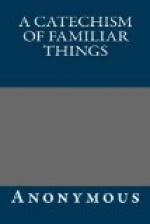What is a Lightning Rod?
It is a rod of iron placed against a building to protect it from lightning. Three or four feet of one end is in the moist ground or in water, while several feet of the other end extend above the highest part of the building. The upper end of the rod is pointed with copper or some other metal which will not easily corrode.
By whom was it invented?
By Benjamin Franklin, and first announced by him in his “Poor Richard’s Almanac” for 1753. Franklin was born at Boston, Mass., in 1706. By his talents, prudence, and honesty he rose from humble beginnings to be one of the foremost men of his time. He was one of the committee of five chosen by Congress to prepare the “Declaration of Independence” which he with other patriots afterwards signed. Towards the close of the year 1776 he was sent as ambassador to the French Court, and remained in Europe some time. He returned home in 1785, and died at Philadelphia on the 17th of April, 1790.
What is the Gulf Stream?
It is a warm current in the Atlantic Ocean.
What is its origin?
It may be considered as beginning on the west coast of Africa, within the region of the trade winds. These cause a westward flow, known as the equatorial current. On reaching the coast of Brazil, the greater portion of this current bends northward, carrying with it the waters of the Amazon and Orinoco, and passes through the Caribbean Sea into the Gulf of Mexico. Here it is further heated, and rushes out through the only outlet, the Straits of Florida.
Describe its course.
Deep and narrow, it runs by Florida with a velocity varying from two to five miles an hour, and pressed by the cold current between it and the shore, flows parallel to the coast as far as Cape Hatteras. Meeting shoals near this point, the banks of sand extending as far as Newfoundland, it there turns abruptly to the east, and with diminished speed and increased width, rolls onward towards the coast of Europe. Before long it divides into two great branches—the northern and southern. The former extends as far as Spitzbergen; the latter, sweeping along by the Madeira and Canary Islands, returns to the equator, completing the circuit.
What influence has the Gulf Stream on the climate of Europe?
Various opinions have been expressed as to this. It has been estimated that the amount of heat arising from the stream on a winter’s day, is sufficient to raise the atmosphere over the British Isles from the freezing point to a summer temperature.
How may the Gulf Stream be distinguished?
It can be distinctly traced in the ocean by its dark indigo color, its temperature, and the swiftness of its waters.
Which is the largest tunnel in the world?
The Mt. Cenis Tunnel, or the tunnel of Col de Frejus, by both of which names it is known. It is the longest subterranean route for commerce and travel yet constructed, being 7-1/4 miles in length. It is on the crest of the Cottian Alps, about 16 miles south-west of the summit of Mt. Cenis Pass. It was begun in 1857, and finished in 1871.




